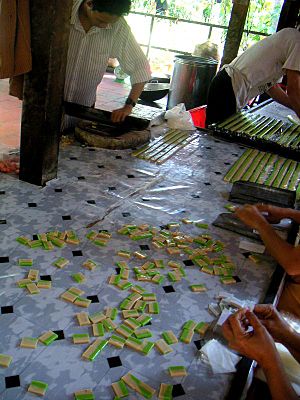Coconut candy facts for kids
 |
|
| Type | Confectionery |
|---|---|
| Place of origin | Vietnam |
| Region or state | Bến Tre Province |
| Main ingredients | Coconut, malt syrup, sugar |
Coconut candy is a sweet treat made with coconut or coconut flavors. It's a popular type of confectionery enjoyed by many people around the world.
In Vietnamese cuisine, a special kind of coconut candy called "kẹo dừa" is very famous. It's mostly made in Bến Tre Province in Vietnam. This candy uses coconut milk and coconut cream to give it a rich, creamy taste.
In other places, like the United States, coconut candy can also be found. It often uses grated coconut, especially in chocolate sweets.
Contents
Coconut Candy in Vietnam
The Bến Tre Province in Vietnam is often called the "Land of Coconut" (Xứ Dừa) because so many coconuts grow there. The Vietnamese name for coconut candy is "kẹo dừa," which means "candy" (kẹo) and "coconut" (dừa). This candy first became popular in a small town called Mỏ Cày District within Bến Tre province.
How Vietnamese Coconut Candy is Made
Making Vietnamese coconut candy is a special process. It starts with fresh coconuts.
Getting the Coconut Cream
First, the fresh coconut meat is grated into tiny pieces. Then, these grated pieces are pressed very hard to squeeze out the rich coconut milk and cream. This creamy liquid is the main ingredient for the candy.
Mixing and Cooking
Next, malt syrup and sugar are added to the coconut milk and cream. Each candy maker has a secret recipe for how much of each ingredient to use. This secret recipe is often kept within the family. Even small changes in the amounts can make the candy taste and feel very different!
The mixture is then heated in large pots called woks. These woks are placed over fires that use coconut shells as fuel. Workers stir the mixture all the time to make sure it cooks evenly. Long ago, people stirred by hand with big wooden paddles. Today, bigger factories might use electric motors to do the stirring.
As it cooks, the mixture gets thicker and turns into a caramel-like texture. Knowing exactly when it's cooked enough is a skill that takes practice.
Shaping and Wrapping
While the candy mixture is still hot and soft, it's pulled into long strings and put into molds. Then, it's left to cool down. Once it's cool, the long candy strings are cut into small, rectangle shapes.
Traditionally, these candies were wrapped in two layers. The inside layer was edible rice paper, and the outside layer was paper soaked in vegetable oil. This stopped the candy from sticking. Now, many bigger companies use special foil paper that doesn't stick and is sealed with heat.
Why Coconut Candy is Important to Bến Tre
Coconut candy is very important to the economy of Bến Tre province. There are more than one hundred coconut candy makers there! This makes up about 30% of all the local businesses.
Even though there are many makers, a few well-known brands sell most of the candy. Many smaller companies make candy under a license for these bigger brands. Coconut candy is sold all over Vietnam. It's also sent to other countries in Asia, Australia, Europe, and North America.
Other Coconut Candy Types
Many other candies around the world also contain coconut. Here are a few examples:
- Bounty (chocolate bar) (a chocolate bar with coconut inside)
- Coconut ice (a sweet treat made with coconut and sugar)
- Ferrero Raffaello (a crispy candy with a creamy coconut filling)
- Perle de coco
- Ounhmangu
Images for kids
-
Alfajor from Mexico
-
Neapolitan coconut candies
See also
 In Spanish: Caramelo de coco para niños
In Spanish: Caramelo de coco para niños














